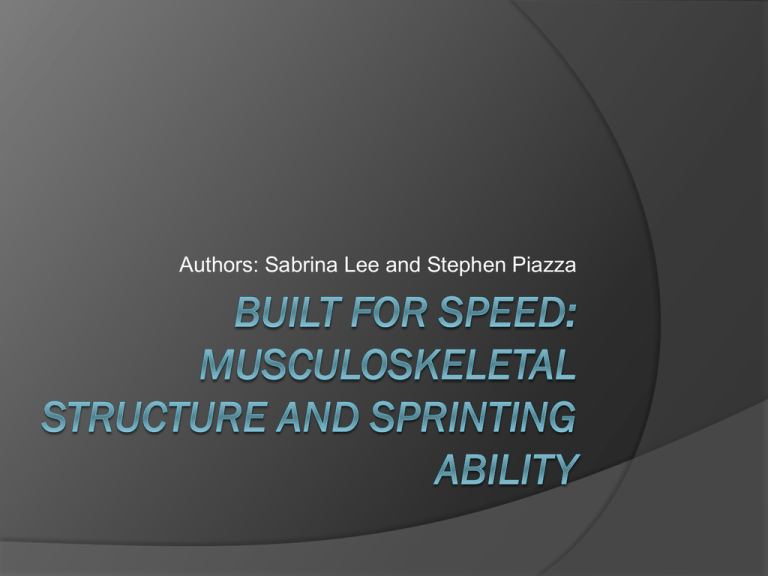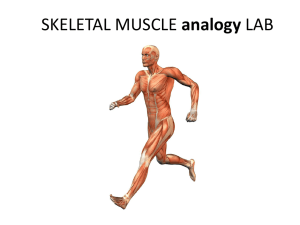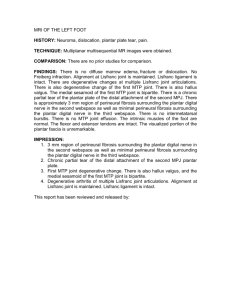Built for Speed: Musculoskeletal Structure and Sprinting Ability
advertisement

Authors: Sabrina Lee and Stephen Piazza I. Introduction The fastest sprinters: Higher proportion of fast-twitch muscle fibers Larger leg muscles A muscle with a large moment arm about a joint (generates large torques) The ability to accelerate separates good sprinters from world class sprinters. Accelerate the most during the first 30m of 100m sprint The leg muscles must perform maximum concentric work Morphological Research The structure of the foot and ankle in combination with muscle moment arms are determinative of locomotor speed. Cheetahs, who can reach 70mph in 3 sec., have plantar flexor muscles that attach close to the ankle joint center with a large distance between the point of application for the ground reaction force Thus the fastest runner’s have higher gear ratios (MA of the GFR divided by the moment arm of the muscle) MA Ratios: Cheetah vs. Lion Cheetahs have long toes and very short heel bones large “gear ratio” High gear ratios can place a muscle at a disadvantage, but is overridden by the high muscle forces it permits Fascicle Length/MA Ratio The ratio of the fascicle length to moment arm has been identified as a determinant of the range of joint motion over which a muscle may generate force. The muscle moment arm and the number of sacromeres determine the magnitude sacromeres will shorten/lengthen for a given rotation Purpose The purpose of the study was to measure the plantar flexion moment arms of the Achilles’ tendon, plantar flexor muscle architecture parameters, and foot and ankle anthropometric characteristics in sprinters and nonsprinters. As far as the authors’ knowledge extends this is the first study of plantar flexor moment arms in sprinters. II. Materials and Methods Participants: 12 collegiate sprinters & 12 height matched non-athletes Ultrasonography: This technique was used to determine muscle fascicle lengths as well as pennation angles (specifically of the lateral gastrocnemius) It was also used to determine tendon excursion during ankle plantar flexion and to compute the plantar flexion moment arm of the Achilles’ tendon. Computer Model: To study the effects of muscle and joint structure on sprint performance, a planar, forward-dynamic simulation of the push-off phase was developed III. Data & Results Plantar flexion moment arms of the sprinters were 25% smaller than non-sprinters Sprinters had longer gastronemius fascicles than non-sprinters The mean ratio of fascicle length to plantar flexor lever arm was almost 50% higher in sprinters than non-sprinters The average toe length was 9 mm longer in sprinters than non-sprinters The length of the fibular head to lateral malleolus was 30 mm shorter in sprinters. Table 1. Anthropometric characteristics and ages of the sprinter and non-sprinter subjects Spinters Non-sprinters P-value Stature (cm) 181.4 (+/-) 8.0 180.9(+/-)7.6 0.874 Body Mass (kg) 77.0 (+/-) 6.5 76.8(+/-)9.5 0.954 Age (yrs) 19.3(+/-) 1.2 25.4(+/-)2.8 <.001 Fibular head to lateral malleolus (cm) 41.1 (+/-) 2.6 44.1(+/-)3.5 0.026 Heel to toe (cm) 27.4 (+/-) 1.1 26.9(+/-)2 0.473 Heel to 1st metatarsal head (cm) 19.2 (+/-) .9 19.5(+/-)1.6 0.485 Heel to lateral malleolus (cm) 5.5 (+/-)0.7 5.6(+/-)0.3 0.594 Lateral malleolus to 1st metatarsal head* (cm) 13.7 (+/-) 0.7 13.9(+/-)1.4 0.589 Lateral malleolus to toe* (cm) 21.9(+/-)0.9 21.3(+/-)1.8 0.305 First metatarsal head to toe* (cm) *These values were not measured directly but were derived by subtraction from measured quantities 8.2(+/-)1.0 7.3(+/-)0.9 0.032 Table 2. Musculoskeletal architecture parameters for the lateral gastrocnemius measured from ultrasound images Sprinters Non-sprinters P-value LG thickness (mm) 15.5(+/-)1.9 14.7(+/-)2.0 0.33 LG pennation angle (deg.) 12.8(+/-)1.2 13.7(+/-)2.1 0.212 LG fascicle length (mm) Achilles' tendon moment arm (mm) 69.9(+/-)6.2 62.7(+/-)8.3 0.024 31.0(+/-)3.7 41.6(+/-)5.5 <.001 Fascicle length:moment arm 2.28(+/-).32 1.53(+/-).27 <.001 LG, Lateral gastrocnemius Forward Impulse TL Varied and Held Constant at 35mm Forward Impulse PF MA varied and TL Held Constant at 75mm IV. Applications Evolution- Early hominids had 40% longer toes than modern humans, suggesting that shorter toes evolved because they require less muscle effort and are more economical over endurance distances. Longer toes allow more propulsive force, permitting greater acceleration Specially designed track shoes V. Conclusions Sprint performance depends upon muscle structure as well as composition. Sprinters achieve rapid acceleration with short plantar flexor moment arms in combination with long fiber lengths. Longer toes increase contact time, increasing time for acceleration. Questions?










